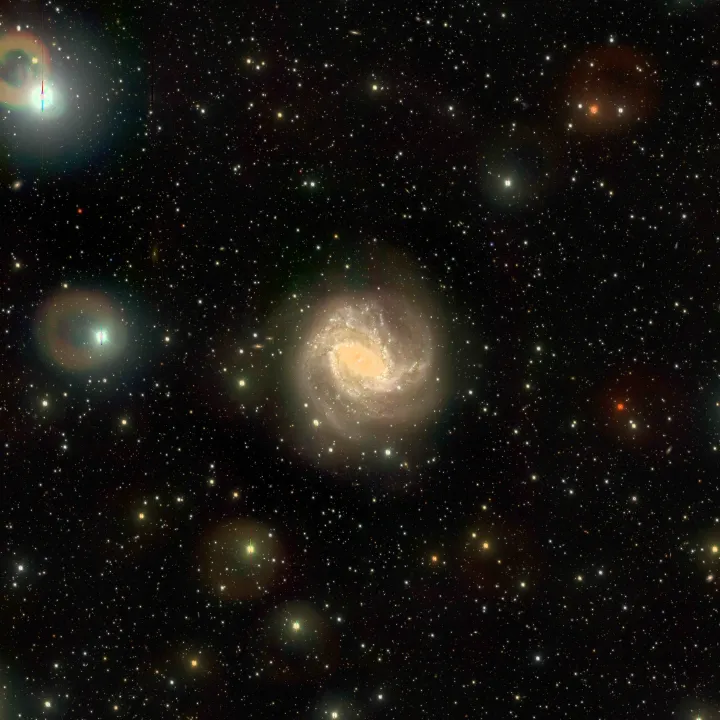 Image of the irregular dwarf galaxy Sextans A, located at a distance of about 4 million light years from us, towards the edge of the Local Group, captured by the VST (VLT Survey Telescope), an Italian telescope managed by the Italian National Institute for Astrophysics (INAF) at ESO’s Paranal Observatory, Chile.
INAF/VST-SMASH/C. Tortora et al. (2024)
Image of the irregular dwarf galaxy Sextans A, located at a distance of about 4 million light years from us, towards the edge of the Local Group, captured by the VST (VLT Survey Telescope), an Italian telescope managed by the Italian National Institute for Astrophysics (INAF) at ESO’s Paranal Observatory, Chile.
INAF/VST-SMASH/C. Tortora et al. (2024)
A gorgeous new set of images shows the striking sight of nearby galaxies, captured by a telescope called the VLT Survey Telescope (VST), located at the European Southern Observatory (ESO)’s Paranal Observatory in Chile. Some of these galaxies are well-known, like the famous Sextans A, which is a small dwarf galaxy with an unusual square shape that is located just 4 million light years away.
Sextans A, shown above, is just a fraction of the size of our Milky Way galaxy at only 5,000 light years across and has been shaped by epic supernova events as stars come to the end of their lives and explode, pushing the material of the galaxy into its odd configuration.
 Image of the irregular galaxy NGC 3109, located at a distance of about 4 million light years from us, toward the edge of the Local Group, captured by the VST (VLT Survey Telescope), an Italian telescope managed by the Italian National Institute for Astrophysics (INAF) at ESO’s Paranal Observatory in Chile. INAF/VST-SMASH/C. Tortora et al. (2024)
Image of the irregular galaxy NGC 3109, located at a distance of about 4 million light years from us, toward the edge of the Local Group, captured by the VST (VLT Survey Telescope), an Italian telescope managed by the Italian National Institute for Astrophysics (INAF) at ESO’s Paranal Observatory in Chile. INAF/VST-SMASH/C. Tortora et al. (2024)It was studied along with other galaxies like the nearby NGC 3109, shown above, to learn how galaxies form, as part of a project called The VLT Survey Telescope Survey of Mass Assembly and Structural Hierarchy (VST-SMASH). In total, the project covered 27 galaxies.
“We strive to understand how galaxies are formed as a function of their mass and morphology. This means asking ourselves how stars are formed in situ, within galaxies, but also how they are accreted (ex situ) during merger processes with other galaxies,” explained lead researcher Crescenzo Tortora of the Italian National Institute for Astrophysics. “In order to do so, we need to trace the colors of these galaxies up to their outskirts to investigate the presence of faint structures belonging to these galaxies and of faint galaxies orbiting around them. This is useful to uncover leftovers from galactic interactions, constraining the hierarchical process of cosmic structure formation.”
 Image of the spiral galaxy IC 5332, located at a distance of about 30 million light years from us, captured by the VST (VLT Survey Telescope), an Italian telescope managed by the Italian National Institute for Astrophysics (INAF) at ESO’s Paranal Observatory in Chile. INAF/VST-SMASH/C. Tortora et al. (2024)
Image of the spiral galaxy IC 5332, located at a distance of about 30 million light years from us, captured by the VST (VLT Survey Telescope), an Italian telescope managed by the Italian National Institute for Astrophysics (INAF) at ESO’s Paranal Observatory in Chile. INAF/VST-SMASH/C. Tortora et al. (2024)Other galaxies studied in the project include the spiral galaxy IC 5332, located 30 million light years away, the irregular galaxy NGC 5253, located 11 million light years away, and NGC 5236, also known as the Southern Pinwheel, located 15 million light years away. The Southern Pinwheel is a particularly striking barred spiral galaxy that is one of the closest and brightest in the sky — so close that you don’t even need a telescope to see it, as it can be observed using binoculars.
 Image of the spiral galaxy known as Southern Pinwheel (also referred to as NGC 5236 or M 83), located at a distance of about 15 million light years from us, captured by the VST (VLT Survey Telescope), an Italian telescope managed by the Italian National Institute for Astrophysics (INAF) at ESO’s Paranal Observatory in Chile. INAF/VST-SMASH/C. Tortora et al. (2024)
Image of the spiral galaxy known as Southern Pinwheel (also referred to as NGC 5236 or M 83), located at a distance of about 15 million light years from us, captured by the VST (VLT Survey Telescope), an Italian telescope managed by the Italian National Institute for Astrophysics (INAF) at ESO’s Paranal Observatory in Chile. INAF/VST-SMASH/C. Tortora et al. (2024)“This is the first time that all these galaxies are observed in such a deep and detailed fashion and with homogeneous data,” Tortora said. “In coming years, only Euclid will reach comparable depth in the optical domain, but without the same wide spectral range at the VST optical wavelengths. The Vera Rubin Observatory, instead, while observing in similar spectral regions to ours, will reach similar depths only after many years of observations. This makes the VST an instrument that can still make a difference, making us hope for interesting results as part of our survey.”
 Image of the irregular galaxy NGC 5253, located at a distance of about 11 million light years from us, captured by the VST (VLT Survey Telescope), an Italian telescope managed by the Italian National Institute for Astrophysics (INAF) at ESO’s Paranal Observatory, Chile. INAF/VST-SMASH/C. Tortora et al. (2024)
Image of the irregular galaxy NGC 5253, located at a distance of about 11 million light years from us, captured by the VST (VLT Survey Telescope), an Italian telescope managed by the Italian National Institute for Astrophysics (INAF) at ESO’s Paranal Observatory, Chile. INAF/VST-SMASH/C. Tortora et al. (2024)Further information is published in the ESO magazine The Messenger .

Georgina has been the space writer at Digital Trends space writer for six years, covering human space exploration, planetary…
James Webb is explaining the puzzle of some of the earliest galaxies

From practically the moment it was turned on, the James Webb Space Telescope has been shaking cosmology. In some of its very earliest observations, the telescope was able to look back at some of the earliest galaxies ever observed, and it found something odd: These galaxies were much brighter than anyone had predicted. Even when the telescope's instruments were carefully calibrated over the few weeks after beginning operations, the discrepancy remained. It seemed like the early universe was a much busier, brighter place than expected, and no one knew why.
This wasn't a minor issue. The fact early galaxies appeared to be bigger or brighter than model predicted meant that something was off about the way we understood the early universe. The findings were even considered "universe breaking." Now, though, new research suggests that the universe isn't broken -- it's just that there were early black holes playing tricks.
Read more
Event Horizon Telescope can now take images of black holes that are 50% sharper

The Event Horizon Telescope project, the group that took the first-ever image of a black hole, has made another historic breakthrough, making the highest-ever resolution observations of space taken from the Earth's surface. The project uses facilities around the globe to turn the Earth itself into a giant observatory, which is capable of taking highly precise measurements of distant galaxies.
The latest observations made use of the Atacama Large Millimeter/submillimeter Array (ALMA), a large array of radio telescopes located in Chile, as well as other facilities in Spain, France, and Hawaii. To get higher-resolution images than previous observations, scientists weren't able to make the telescope bigger -- as it was already the size of the Earth -- so they observed at a higher frequency instead.
Read more
James Webb Telescope captures gorgeous galaxy with a hungry monster at its heart

A new image from the James Webb Space Telescope shows off a nearby galaxy called Messier 106 -- a spiral galaxy that is particularly bright. At just 23 million light-years away (that's relatively close by galactic standards), this galaxy is of particular interest to astronomers due to its bustling central region, called an active galactic nucleus.
The high level of activity in this central region is thought to be due to the monster that lurks at the galaxy's heart. Like most galaxies including our own, Messier 106 has an enormous black hole called a supermassive black hole at its center. However, the supermassive black hole in Messier 106 is particularly active, gobbling up material like dust and gas from the surrounding area. In fact, this black hole eats so much matter that as it spins, it warps the disk of gas around it, which creates streamers of gas flying out from this central region.
Read more













)





 English (US) ·
English (US) ·